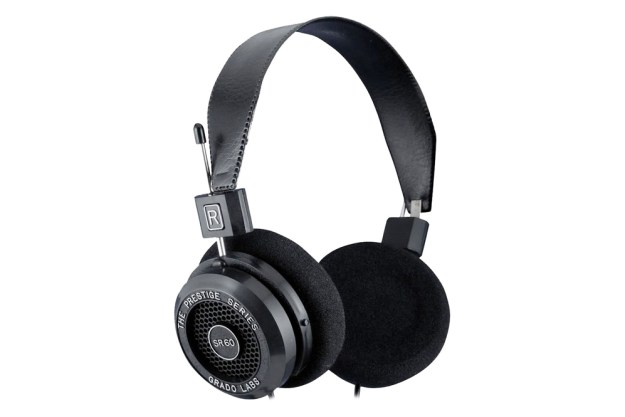
“Even if you can spend more, you owe it to yourself to listen to the Grado SR60i before purchasing your next set of headphones.”
- Wide-open, clear, and well-detailed sound
- Awesome midrange and vocal detail
- Deep, tight, and articulate bass
- Fatigue-free and pristine treble
- Sounds great on all different kinds of music
- Surprisingly comfortable fit and design
- Space-age looks may be off-putting for some
- Foam earpad cushions can wear out over time
When it comes to headphones, there’s been an embarrassment of riches lately, so much so that it’s not uncommon to see completely different model lineups every year. Manufacturers seem to be churning out new designs or styles as soon as we start getting used to seeing what’s out there, perhaps in an effort to continuously impress us with something new. You’d be lucky to find cans from just three or four years ago still on the store shelves.
Perhaps that’s what makes Grado Labs something of an oddity in the headphone game. Its lineup consists mainly of headphones that have been around for at least five and ten years, and the Grado SR60i, the subject of this review, is one of the oldest in the bunch — it’s been in continuous production and virtually unchanged for nearly 20 years.
Of course, no headphones would be on the market for so long if they weren’t any good, and many audiophiles considered the original SR60 to be one of the best-sounding set of cans you could get for under $100. But given all the progress that’s been made with
Out of the box
One thing’s for sure: the Grados certainly don’t look like any other headphones on the market. The SR60i’s earpieces slide up and down on metal rods reminiscent of radio antennas from days gone by, and the round, perforated, black plastic earpieces look decidedly retro in a Jetsons sort of way. For sure, their overall design reminds us of some 60’s space-age contraption originally intended to beam Martian communication signals into our heads. But we’ve grown accustomed to the SR60i’s aesthetics over the years, and we’ve come to think of their appearance as very unique and eye-catching.
Features and design
The Grado SR60is have remained relatively unchanged over the years, and it’s easy to see just how utilitarian their unique design is. Those aforementioned outer shell earpiece perforations are necessary for the Grado’s open-back, supra-aural (on the ear) design. Unfortunately that means they’re not suitable for use while commuting or on public transport, since they will leak a lot of sound and let quite a bit in as well. Bottom line: Use the SR60is where ambient noise and proximity to others are both very low.

Neither the headband nor earpieces feature any sort of leatherette cushioning, though the headband does have a vinyl wrap for some comfort relief. In fact, the only other nod to comfort is the foam earpiece cushions. Even though they are a very old school form of padding, they do the job well enough. We know from experience however that over time the foam earpads can lose their resiliency, so those who will be using the Grados for the long haul may want to investigate one of the upgraded cushions available. We stuck to using the SR60i in stock form for this review however, and we found the SR60i to be very comfortable overall and didn’t have any undue clamping force or head pressure thanks to their simple, on-ear design.
About the only things that have ever been updated in these Grados are the drivers and the cable’s wiring. Unfortunately, no information on the new drivers or cable features is given, save for a higher conductor count. That must explain why the cable is now thicker than we remember, which is quite a bit more robust and durable than we’re used to seeing on cans of this price. Oh, and speaking of price, we forgot to mention that the SR60i’s price has also remained relatively unchanged: They’re now a mere $79 instead of the original price of $69.
Performance
We used the Grado SR60i the way we figured most folks purchasing headphones in this price range would: straight from the headphone outputs of an iPhone 4, iPod shuffle, Dell Latitude D810 laptop, and Marantz SR6007 and NR1602 receivers. Just for kicks, we hooked them up to our Schiit Lyr headphone amp as well. We also kept handy hand several pairs of
And now we get to the reason why anyone buys a pair of Grado headphones: The sound. Grados are known for combining musicality and audiophile-approved sound quality, and in these regards the SR60i did not disappoint. The Grado SR60i’s sonic character is defined by its top-to-bottom openness, coupled with a smooth, crystal-clear tonal balance and slightly warm bass.
Perhaps the one area where the Grado’s amazing openness and clarity really makes them stand out is in its midrange detail. Listening to Jane Berkin and Serge Gainsbourg’s self-titled French language album, the SR60i’s reproduced all of the fine purity to both singers’ enunciation that simply made it easier to understand and translate their lyrics. We could also more clearly hear Gainsbourg’s subtle vocal inflections and phrasing nuances, and both voices just sounded more realistically natural overall.
The Grado’s midrange detail also made densely-layered music much easier to listen to. We could effortlessly pick out individual instruments within the deep arrangements of Hothouse Stomp by Brian Carpenter’s Ghost Train Orchestra, for example, and the wonderful cacophony of strings, choir, and various other sounds on Grizzly Bear’s Veckatimest were better separated and sounded more like distinct entities than with other similarly-priced headphones. Those who tend to focus on the meat of the music in the midrange will not be disappointed.

Moving down to the bass, the Grado SR60i easily had some of the tautest, deepest, and best-defined bass we’ve ever heard from sub-$100 pair of headphones. Regardless of what we played, we could easily hear well-defined notes and pitches from both electronic and acoustic bass instruments, and bass-heavy tracks, such as “Red Eye,” from The Album Leaf’s Into the Blue Again, positively purred in our ears.
One possible word of caution with the SR60i: Those who aren’t used to hearing an audiophile pair of headphones may initially find the Grado’s way of doing bass to be ever-so-slightly lean, especially compared more modern cans, such as the Bowers and Wilkins P5 or Sennheiser MM500-X. For example, listening to the bass guitar on “4:08,” from Clutchy Hopkins’ The Life of Clutchy Hopkins, the P5s sounded fuller and richer through the bass than the Grados. Still, listen longer and you’ll hear that the Grados actually had better bass clarity and pitch definition than the P5s, and sounded more articulate overall.
Going to the other end of the sonic spectrum, the Grado SR60i also have one of the cleanest, purest, and most wide open trebles we’ve heard from such a reasonably priced set of headphones. Listen to any music that’s heavy on the cymbals, such as jazz or hard rock, and they’ll shimmer with more realistic harmonic delicacy, nuance, and decay information than most other
Conclusion
If it weren’t clear by now, we couldn’t be happier with the Grado SR60i headphones. What they lack in frills or features, they more than make up for in sound quality, combining a wide-open and fairly neutral balance with excellent clarity and detail. Their tonal purity and truth of timbre works well with all kinds of music and should satisfy both sound and music geeks alike.
While we realize that some folks may be put off by their unique aesthetics, we think it’s something you just might come to love over time, as we did. But considering the sound quality that’s on offer, there’s no questioning their performance chops: Not only have the Grados stood the test of time, they still remain at the top of the sub-$100 heap, and even compare favorably with other headphones at two or even three times their modest asking price.
Bottom line: Even if you can spend more, you owe it to yourself to listen to the Grado SR60i before purchasing your next set of headphones: They just might be all the headphone you’ll ever need.
Highs:
- Wide-open, clear, and well-detailed sound
- Awesome midrange and vocal detail
- Deep, tight, and articulate bass
- Fatigue-free and pristine treble
- Sounds great on all different kinds of music
- Surprisingly comfortable fit and design
Lows:
- Space-age looks may be off-putting for some
- Foam earpad cushions can wear out over time



